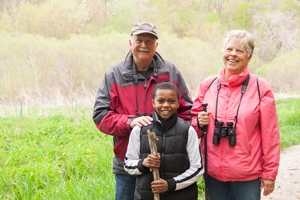
2014 Art at Riverside Park
The Urban Ecology Center is a neighborhood-based, not-for-profit environmental, community center that educates and inspires people to understand and value nature as motivation for positive change, neighborhood by neighborhood. Our quarterly Art Shows support this mission through locally produced, nature-related artwork.
All Opening Receptions are 5 - 7 pm, with artists speaking informally at 6.
Refreshments provided. Urban Ecology Center - Riverside Park, 1500 E. Park Place, Milwaukee
Water and Light
January through March 2014
Opening Reception Thursday, January 16th, 5 - 7 pm
Abstraction and intimacy, water and light connect Kurt Kleman’s dramatic large-scale acrylic paintings (“shimmer” series) and Thea Kovac’s vibrant watercolors (“Floating Light” series). You might become mesmerized by our rivers and Lake Michigan all over again. In delightful and engaging counterpoint are bird carvings by Tom Petri.
Sara Daleiden, director of MKE <-> LAX will be on hand to host the event as well as moderate the question & answer session with the artists.
 |
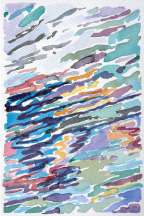 |
 |
|
“18”, Shimmer series |
Floating Light series |
Black-capped Chickadee |
Visual Reflections: Printmaker Collective
April through June 2014
Opening Reception Thursday, April 10th, 5 - 7 pm
By invitation, twelve fine art printmakers were linked with twelve ecologists, to engage in a conversation that inspired visual representations of each ecologist’s story. Bench Press Events organized this exhibit for the World Conference of the Society for Ecological Restoration to encourage further insight into the work of ecological restoration.
 |
 |
|
“Diversity in Small Parcels” |
“Return, Take Over” |
Additional artists: Kim Hindman, Niki Johnson, Jay Wallace, Rhea Ewing, Yvette M. Pino, Douglas Bosely, Laura Grossett, Tyler Green, Jonas Angelet, Kris Broderick
Intimate Nature
July through September 2014
Opening Reception Thursday, July 10th, 5 - 7 pm
Two artists pay close attention to nature’s details. Kristin Gjerdset sees the world underfoot - often overlooked, yet as deserving of reverence as grand scenery. Hers is the world of tiny shrubs and flowers, visited by winged beings and fur-bearing creatures. Jamie Bilgo Buchman notices the natural world in our everyday lives and asks questions: where do things come from? How do they work? What does this mean?
 |
 |
|
“Horicon Marsh: A Day” |
“Veining” |
The Mysterious, Magical World of Nature at Night
October through December 2014
Opening Reception Thursday, October 9th, 5 - 7 pm
Timothy Haglund is primarily a plein air painter. He works in nature, at night, a time that is unique and not always experienced by outdoor enthusiasts. Nature at night is a magical, mysterious time where one’s awareness of their surroundings is heightened, and one’s presence in the landscape feels noticeably alone. It is a time to come to know the land one exists within. The time, the mood, that stillness is alive in the subtleties of these painted night-scapes.

“Bats Over the River”
Timothy Haglund
Oil on gessoed birch plywood
Being / Seeing
January through March 2015
Opening Reception Thursday, Jan 8th 2015, 5-7 pm
A continuing quest into being and seeing. Joyce Winter describes her paintings as a dance on paper using color, texture and space - a process that seems to connect memory and sensory impressions of our relationships with nature. Michael Kutzer paints one place, Seminary Woods, in its many moods. He is interested in how the working of your eyes, and your ability to focus at multiple distances, affects how and what you see in nature.
 |
 |
|
“This is Our Heritage” |
“Target 36: Forest’s Heart” |
2015 Art at Riverside Park
The Urban Ecology Center is a neighborhood-based, not-for-profit environmental, community center that educates and inspires people to understand and value nature as motivation for positive change, neighborhood by neighborhood. Our quarterly Art Shows support this mission through locally produced, nature-related artwork.
New this year is our first-ever art show at our Menomonee Valley branch!
All Opening Receptions are 5 - 7 pm, with artists speaking informally at 6.
Refreshments provided. Urban Ecology Center - Riverside Park, 1500 E. Park Place, Milwaukee
The Urban Ecology Center typically issues an annual Call for Artists in the fall of each year, to choose artists for up to six quarters ahead. Watch this page for information.
Artworks are often available for purchase. The artist contributes a portion of the sales price to the Urban Ecology Center. If you would like to purchase an artwork, please speak to Riverside Park branch manager Jamie Ferschinger or another Urban Ecology Center staff member.
Being / Seeing
January through March 2015
Opening Reception Wednesday, February 11th 2015, 4:30-7 pm
Joyce Winter describes her paintings as a dance on paper using color, texture and space - a process that seems to connect memory and sensory impressions of our relationships with nature.
With a collection entitled aRound the Deer Creek, Michael Kutzer shows one place, Seminary Woods, in its many moods. The compositions’ round shape, circles and center are inspired by old painted targets, but their meaning has become more spiritual.

“This is Our Heritage”
Joyce Winter
Acrylic-prisma pencil on watercolor paper, 40”x32”

“Target 36: Forest’s Heart”
Michael Kutzer
Acrylic, 20”x20”
Sacred Places
April through June 2014
Opening Reception Thursday, April 9th, 5 - 7 pm
Kevin Muente's paintings make the viewer understand that we need to protect as many wild places as possible no matter how big or small. At times the window of the canvas frames and perhaps allows places that are in our own communities to rival images of the greatest national parks.

Ghost Garden
July through September 2015
Opening Reception Thursday, July 9th, 5 - 7 pm
Ghost Garden is a collection of memories in the form of botanical prints. Plants gathered from Vicki Reed's gardens, and from outings with her elderly patients, were used to create lumen prints - a historical technique of placing leaves and blossoms on photographic paper to produce ghost images of the original plants.

The Nature of Prints
October through December 2015
Opening Reception Thursday, October 8th, 5 - 7 pm
Sally Duback: In making paper from rags, re-using natural materials that have been discarded, Duback’s finished works carry a deep level of meaning.
Barbara Manger: A river’s pulse and energy, secrets and constant change,lead Manger to explore and convey tangles, apparent disorder,and the river wending its own path of necessity.

Sally Duback
Specimens on Green
Monoprint / handmade paper, 24x38"
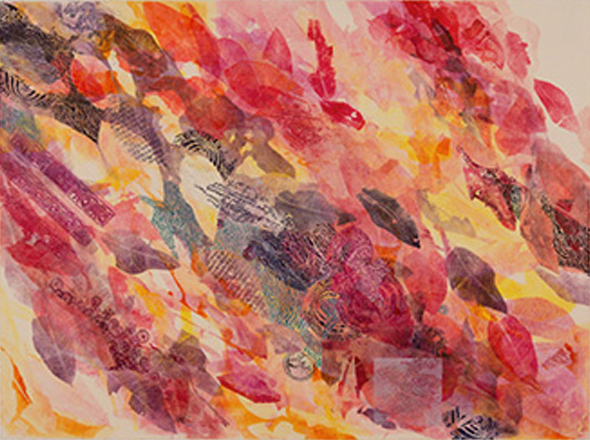
River's Path
Monotype, ink, woodblock, linoleum block, 38x50"
Forest Floor
(A special sculpture exhibit)
Shannon Molter: Take a closer look above and below at the unsung forest understory. Sculptures will usher visitors into the Center, growing along the floor of the entrance alcoves and hanging overhead in the main hall. Molter's fibrous representations of the forest floor aim to create a palpably mysterious, spiritual representation of this rich and misunderstood ecosystem, which begs its viewer to spend time finding beauty in the spaces under foot. Woven from discarded leather scraps cut into leaf litter, sculpted into tree stumps, roots and fallen branches.

Shannon Molter
Detail: Forest Floor
Wood and Stone
January through March 2016
Opening Reception: Thursday, January 14th, 2016, 5-7 pm
Cynthia Brinich-Langlois: The lithographic prints tell a story that begins on the tundra, with the drying up of rivers and ponds, but the series expands to include diverse habitats, and the land itself begins to disintegrate. The work depicts a journey through changing environments, with surreal geographies suggesting an unsettled future.
Ken Vonderberg: The inspiration for creating artwork with the wood burning process or “pyrography” was the notion that wood, as a raw natural material, could be transformed into images through the use of heat, an elemental force, employed in the artist’s vision.
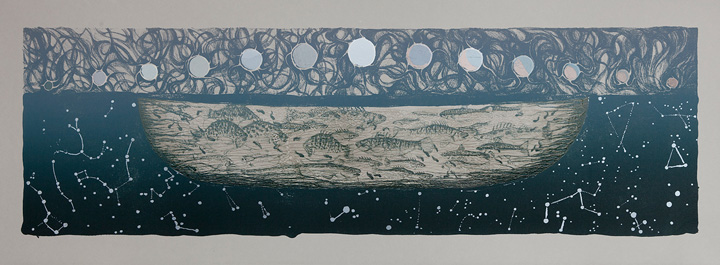
Cynthia Brinich-Langlois
Underworld
Lithograph and hot stamping foil on gray Pescia, 11 x 30 inches, 2014
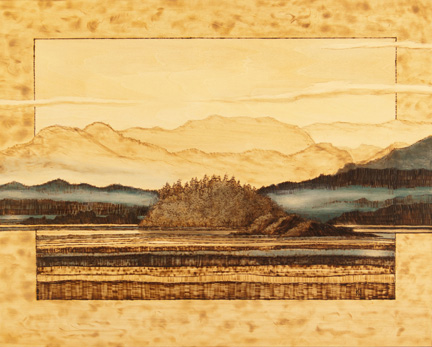
Ken Vonderberg
Blue Ridge
Pyrography & acrylic wash on birch cradled panel 14 x 18, 2014
Take a Hike, Milwaukee!
One of my favorite things to do is be fully immersed in nature while hiking in the middle of the city. The fact that you can walk from a street full of houses into a beautiful green haven in a matter of moments is so amazing!
I love watching people’s faces their first time out hiking in one of the parks at our branches, especially those who have lived in Milwaukee all their lives but have never seen this natural side of their city. It’s great.
I’d like to invite you to take part in an urban nature hike with me!
An Unusual Challenge ... Will You Raise Your Hand?
“Wow! Did I really just say that? ... I sure hope I didn’t offend anyone,” I thought as I stepped from the podium and returned to my seat. It is always a little dicey when I’m asked to speak extemporaneously. Even I am never quite sure what I will say. In this case, I issued a personal challenge to all in attendance at an evening business awards ceremony organized by the Shepherd Express. Upon receiving much positive feedback afterward, I thought that perhaps I should offer this to you as well!
We’re in it Together
It was a crisp autumn day - perfect for a bicycle commute - and I was using my lunch hour to pedal between the Center’s branches. Zipping downhill on Highland Boulevard toward MillerCoors, I hit a big bump that popped my chain out of gear, jamming it so that the pedals would no longer crank. I coasted to a stop and within a few seconds was surrounded by three Harley-Davidson-attired gentlemen. Before I could utter a greeting, one asked if they could help. I nodded yes and within 30 seconds the chain was back in place.
Art at the Urban Ecology Center
To complement our mission of using urban nature to educate, inspire, and motivate people towards positive change, the Urban Ecology Center exhibits artwork in our Riverside Park and Menomonee Valley branches. All of the work displayed feature nature-related subjects, the natural sciences, natural products used as art or the relationship of the urban environment to nature in their themes. Learn more about the history behind these exhibitions in this blog post.
No current art exhibits, check back for an updated schedule. Click here to explore our exhibit archive.
Our Gallery Space
Riverside Park

Artist Michael Kutzer presents his work at an opening reception in our Riverside Park space. Photo: Nancy Aten
At our Riverside Park branch the spacious Community Room serves as gallery, meeting space, and classroom, and with its plentiful wall space typically exhibits two artists concurrently.
Menomonee Valley

Our first ever show at our Menomonee Valley branch featured Plein Air paintings of the area surrounding the Center by local artists. Photo: Jamie Bilgo Bruchman
Our Valley Room hosts exhibits at our Menomonee Valley branch as well as meetings and community programs. This space features plenty of natural light and typically shows one artist at a time.
Contact Info
Do you have questions about our shows? Are you interested in purchasing any of the work displayed? Are you an artist interested in exhibiting your work at the Center? For these and other questions please contact Chris Steinkamp, our Riverside Park Branch Manager at This email address is being protected from spambots. You need JavaScript enabled to view it. or Angélica Sanchez, our Menomonee Valley branch manager at This email address is being protected from spambots. You need JavaScript enabled to view it..
What is Environmentalism? Depends on Who You Ask
I came to the Center two and a half years ago as a summer camp intern. As my role has changed from environmental educator to volunteer coordinator and community health evaluation coordinator, I have found myself reflecting on a question that has repeatedly come up in the various roles I’ve held: What is environmentalism?
It didn’t take long in my role as an educator to notice that how I engaged with nature wasn’t universal. Activities I loved as a child, like catching bugs or sitting quietly in the woods or playing in snow, while appreciated by some, could be terrifying, disgusting or down right boring to some of my students.
A Sense of Tribe
Of all of the things the Native Americans have contributed to society, I think one of the most important is the tribe. Based on kinship, orally communicated customs and rituals and commonly shared values and beliefs, people within the tribes are attuned to others in the group and often work toward shared goals (e.g. food, shelter, healthcare, raising children, etc). They are also each others’ support network. It’s a social construct that has worked for thousands of years.
Copyright © 2023 The Urban Ecology Center

